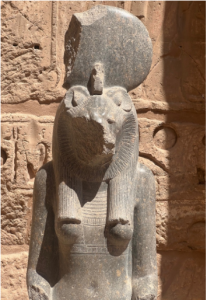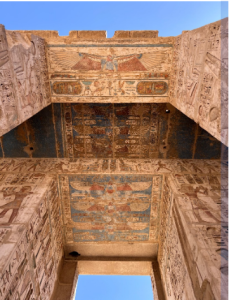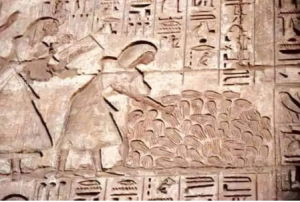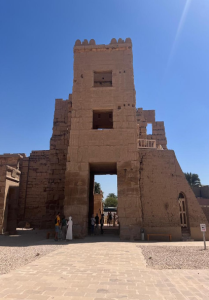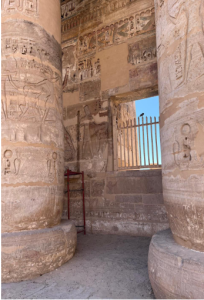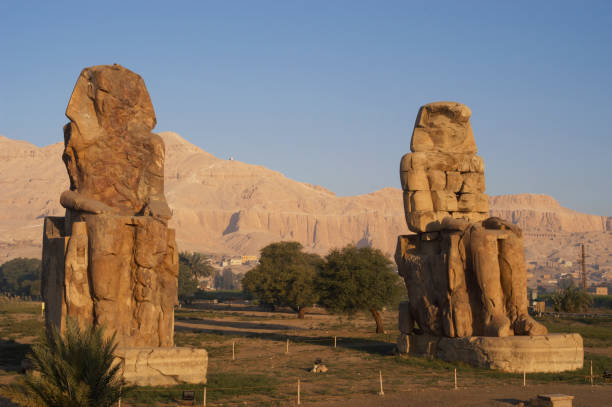The Second Intermediate Period
As we mentioned, the agricultural expansion at the end of the Middle Kingdom, especially during the reign of Amenemhat III, led to migrations from the Levant to Egypt. They settled in the Delta. Some of them even came to rule the Delta (Northern Egypt) and the Egyptians called them the ‘Hyksos’, a term applied to any foreign ruler in Egyptian parlance. They established their capital in Avaris in the eastern Delta and their kingdom extended as far south as Upper Egypt. At the same time, the rulers of Thebes ruled Upper Egypt as far north as Minya and allied themselves with the rulers of Nubia. The Hyksos rule lasted about one hundred and thirty years. However, King “Seqenen ra” and his son “Kamose”, encouraged by the king’s mother Queen “Tetisheri” and his wife Queen “Ahhotep”, “Seqenen ra” fought the Hyksos but was killed in battle. His son Kamose continued the battle against them but was also killed. Queen then encouraged her young son Ahmose (he was 18 years old) to continue the war. When he went to war, he took with him a golden statue of the god Amun, the god of Karnak, and achieved victory in the war. Upon his return from victory, he built a shrine in the Karnak Temple for the god Amun, and all the kings of Egypt after him continued this tradition (building temples in Karnak). Ahmose emulated his mother’s symbol of courage, a golden star, and this star became a symbol for all the military. The Egyptians celebrated the victory and began to say, “Wah wah Iyah,” meaning the appearance of the moon, referring to his mother, Queen “Ahhotep”, who lost her husband and son in the war and yet encouraged her young son to continue the war until victory. This highlights the role of Egyptian women throughout history, their patience, and endurance. (Interestingly, the Egyptians still sing the same song in their celebrations today).
PICTURE OF KING SEQENEN RA II
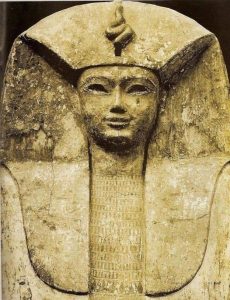
IMAGE OF QUEEN AHHOTEP
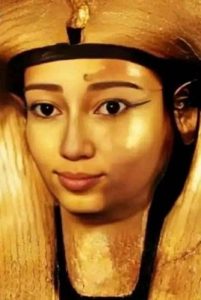
MEMORIAL WAR AXE, A COMBAT TOOL OF KING AHMOSE I
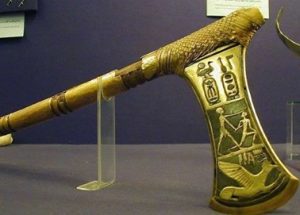
The New Kingdom (18th, 19th, and 20th Dynasties)
The 18th Dynasty King Ahmose I, He was the founder of the 18th Dynasty and the New Kingdom. As we mentioned, he expelled the Hyksos from Egypt and did not stop at expelling them from the Delta but pursued them all the way to Levant, where they completely surrendered to him. The battle took place around 1580 BCE, and this year is considered the founding year of the New Kingdom.
King Ahmose
1. Developed the Egyptian Army: Most notably, he improved the design of war chariots, making them more flexible and powerful than those used by the Hyksos. 2. Continued Construction at Karnak Temple: As previously mentioned, he began construction at the Karnak Temple and not only that, but he also restored the chapel of King “Mentuhotep”, the founder of the Middle Kingdom, in the Karnak Temple. 3. Formed an Army from All Regions of Egypt. He was succeeded by his son, “Thutmose I”.
King “Thutmose I “
He was the first Egyptian king to realize that securing Egypt’s eastern borders must begin outside its borders. Therefore, he conducted military campaigns that extended Egypt’s borders all the way to the lands between the rivers (modern-day Iraq). The rivers referred to are the Tigris and Euphrates. He left a stela on the Euphrates River, writing that Egypt’s borders had reached the inverted river (the ancient Egyptians’ river flowed from south to north, so when he went there, he found the river flowing from north to south, so he considered it inverted). Most importantly, he established his chapel at the Karnak Temple, whose obelisks still exist in the temple. He was also the first king to choose to be buried in the Valley of the Kings.
King Amenhotep III
After the death of King Thutmose III, his son Amenhotep II ruled and then his grandson Thutmose IV (the one associated with the Dream Stela in front of the Sphinx). Then, his son Amenhotep III succeeded him, becoming one of the last pharaohs to maintain the Egyptian Empire. His reign was a period of peace, during which he constructed numerous temples throughout Egypt. Most notably, he began the construction of the Luxor Temple, where, in a chamber near the Holy of Holies, the story of his divine birth was recorded, indicating that he was the son of the god Amun-Ra, like Queen Hatshepsut. He also built a magnificent temple on the west bank, unfortunately, only two colossal statues remain today, now known as “the Colossi of Memnon”. A life-size statue of him and his wife Queen Tiye can be found in the Egyptian Museum in Tahrir Square, highlighting the queen’s powerful personality. Evidence of her influence includes her co-regency with her favored son, Amenhotep IV, during the latter part of Amenhotep III’s reign.
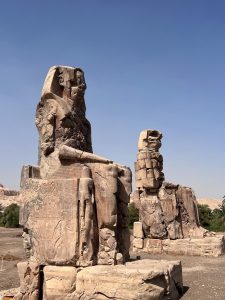
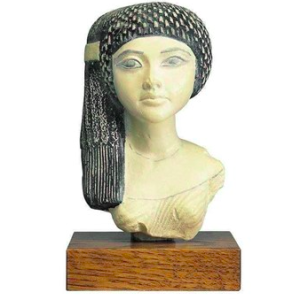
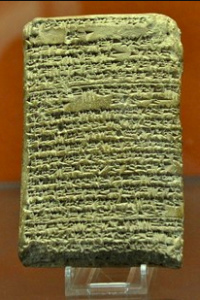
The End of 18th Dynasty
After the death of King “Tut Ankh Amun”, he was succeeded by “Ay”, the High Priest of Amun at Karnak Temple. “Ay”, whose image is depicted in Tut ankh Amun’s tomb undergoing the Opening of the Mouth ceremony. “Ay” did not rule for long. He was followed by “Horemheb”, a military commander, who began to restore Egyptian influence in Levant. One of his most famous achievements was the Laws of Horemheb, considered a constitution for the Egyptian people. He was succeeded by his chief commander, “Seti I”, who founded the 19th Dynasty.
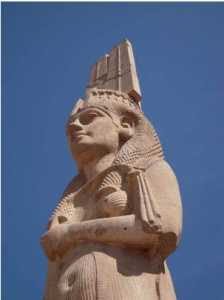
King Merneptah
After Ramses II, his son Merneptah ruled, and from his era, we found a stele called the Israel Stela, which is a victory hymn found by Petrie in 1896 at the Temple of Karnak and is now housed in the Egyptian Museum. In this stela, the word Israel is mentioned for the first time, and it is written that Israel was destroyed. This refers to a group of Bedouin tribes called Israel who lived a nomadic life and have no relation to the Israel of today.

The 20th Dynasty
After the death of Merneptah, some weak kings ruled Egypt until a powerful king named Ramses III ruled. In his reign, he expanded in the Mediterranean and controlled all the islands of the Mediterranean and called its people the “Sea Peoples” and depicted them in his famous temple called the Temple of “Habu”. For this reason, many statues of the goddess “Sekhmet”, the lioness goddess and goddess of war, were found in his temple. There is also a very distinctive scene of him cutting off the hands of his enemies, this scene is depicted because he ordered his soldiers to bring him the hands of his enemies and said his famous phrase: “Cut off the hands of anyone who touches the land of Egypt with evil.” The king also has a scene in the temple, the most important of which is him playing sports with his wives in one of the chambers above the temple gate and wearing home clothes. There are also sports scenes in the temple of games that the Egyptians play even today (such as “Tahtib” term referring to traditional stick-fighting sport). A famous papyrus was found from his era called the “women’s Conspiracy”, which is about one of his wives who wanted to kill him so that her son could rule in his place, but he discovered the conspiracy and killed her and pardoned his son.
End of the 20th Dynasty
After him, the rulers of that dynasty (the 20th Dynasty) became weak, and they were all named Ramses from the fourth to the eleventh. The most famous of their stories is the story of the tomb robberies. A papyrus from the reign of Ramses IX was found in which it is mentioned that tomb robberies occurred after the governors of the east and west of Thebes disagreed, and he conducted an investigation and learned from it that the governor of the west was behind this tomb robberies. The priests in his era gathered the mummies and placed them all in the tomb of Amenhotep I (for fear of them being stolen), and they were found in 1898 by the Frenchman Victor Loret and were transferred to the Egyptian Museum in Tahrir and were transferred in 2022 to the Museum of Civilization. Thus ended the New Kingdom.
